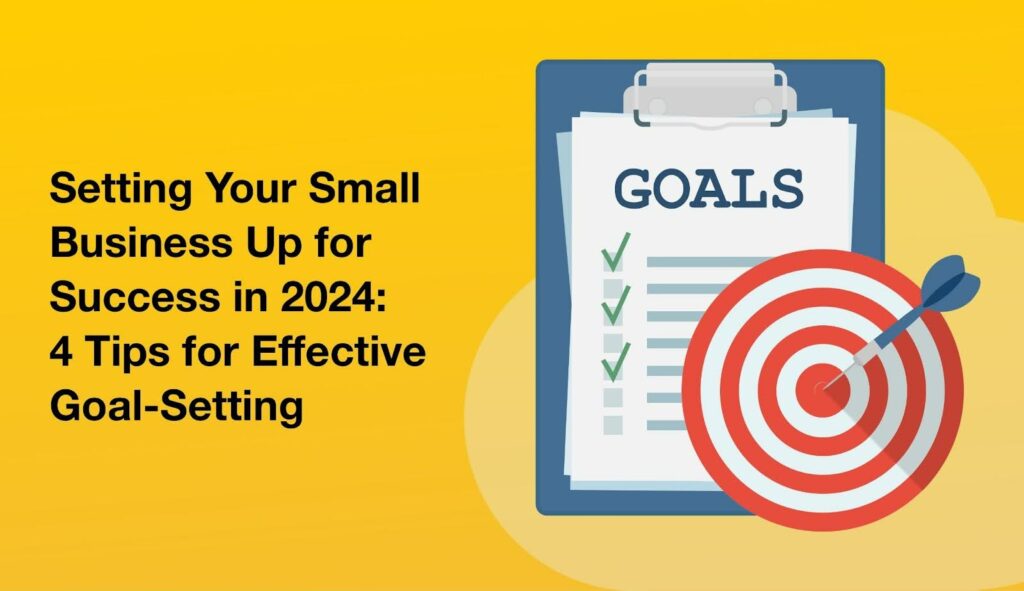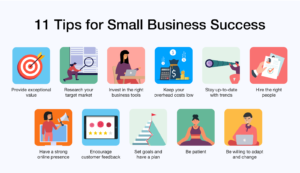As 2023 comes closer and closer to its end, now is the perfect time for small business owners to reflect on their accomplishments and challenges of the past year and start planning for 2024. Setting proper business goals for the new year is a crucial step in ensuring your company’s growth, as it will provide a roadmap to success, helping you and your team stay focused and motivated throughout the year.
In this blog, we’ll discuss how to set goals for your business and explore four valuable tips for setting strategic goals that will make 2024 your most successful year yet.

Summary:
What Are Business Goals?
Business goals are the measurable and achievable objectives a company aims to accomplish within a specific timeframe. These goals serve as a guide or roadmap for the company, setting priorities and standards toward the desired outcomes.
When setting goals for your small business, it’s crucial to understand that they can be short or long-term. While short-term goals typically span a year or less and reflect more urgent needs, long-term goals tend to be broader and include objectives that take longer to accomplish. You can start by setting your long-term goals first and then breaking them down into smaller goals that can be accomplished in the short term.
Long-term goals can be:
- Expand the sales team by adding 5 representatives over the next two years.
- Secure 5,000 clients by 2025.
- Achieve $250,000 in annual revenue by 2027.
- Attain net-zero carbon emissions within 10 years.
While short-term goals can look like this:
- Switch vendors to reduce costs by the end of the month.
- Reduce the sales lifecycle to 2 weeks or less by next quarter.
- Decrease the average time to send invoices by seven days in the next six months.
- Achieve a monthly revenue growth of $20,000 by the end of next year.
Ideally, the short and long-term goals you set for your business should be interconnected in the same strategy, as short-term goals are smaller steps that align with the broader long-term goals. If you reflect on the examples above, the short-term goal of reducing the sales lifecycle to less than two weeks will directly impact the long-term goal of securing 5,000 clients by 2025.
That’s why you should consider both short-term and long-term goals as part of the same strategy, as the successful accomplishment of short-term goals sets the foundation and propels your business forward, ultimately steering it toward fulfilling your long-term aspirations.
Why Goal-Setting Matters for Small Businesses
Goal setting is a fundamental practice for small business owners who are looking to be more successful in 2024. Here’s why:
- Focus and Direction: Goals give your business a sense of purpose and direction. They help you prioritize tasks and make decisions that align with your long-term vision.
- Team Alignment: Goals serve as a shared compass that guides your team’s collective efforts toward a common purpose, fostering unity and focus among team members and ensuring everyone is working towards the same objectives, increasing the odds of success.
- Motivation: There’s no better motivation for you and your team than to achieve a goal. The sense of accomplishment that comes from it can boost morale and improve productivity.
- Measuring Progress: Goals help you measure your business progress and success. They also give you a clear picture of what’s working and what’s not so you can adjust and adapt along the way.
4 Tips for Setting Goals for Small Businesses
1. Reflect on the Past Year
Before setting new goals, it’s important to take a moment to look back and reflect on your business performance this year. Ask yourself:
- What were your main achievements? Did you achieve the goals you set for yourself in 2023?
- What challenges did you face? Most importantly, how did you overcome them?
- What worked and what didn’t? What adjustments did you have to make along the way?
By reviewing your business performance this year, you can identify areas that you need to focus on and set your business up for success by setting more realistic and informed goals for the year ahead.
2. Conduct a Holistic Evaluation of Your Business
A clear understanding of the overall health of your business provides an attainable foundation for goal-setting. We’re talking about a thorough evaluation that encompasses your current financial health, employee performance, and departmental well-being.
Assessing the financial health of your business allows you to set achievable revenue and profit targets, allocate resources wisely, and make informed decisions regarding investments, cost-cutting measures, or expansion strategies. At the same time, evaluating employee performance provides opportunities for recognition, feedback, and skill development, contributing to improved productivity and job satisfaction among your team members. In addition, scrutinizing departmental health allows you to pinpoint strengths and weaknesses within different aspects of your business operations.
This holistic evaluation serves as a compass for you to understand what is working and what isn’t for your workflows, optimize resource allocation, and address potential bottlenecks so you can set achievable and realistic goals for your business.
Pro tip: Use Daylite to have a detailed overview of every aspect of your business. From your sales cycle, projects, and deals to client communications and detailed reports, Daylite gives you a full view of your past and current business performance, so you’re always on top of what needs to be done next.
3. Setting Realistic Business Goals
After doing a thorough evaluation of your business’s overall health, you have a better idea of your current capacities and are ready to set your business up for success by setting realistic goals.
Realistic goals are those that align with the core needs of your business and are practical, achievable, and action-oriented. This distinction ensures that your objectives are firmly rooted in the present realities of your company, acknowledging both its strengths and limitations.
You can start setting realistic goals by differentiating your “needs” from your “wants”. While needs are essential for your core operations, wants are less urgent improvements that can contribute to growth and success. Prioritizing what is really important will be a strategic way to filter your goals and ensure you’re working only on what will bring optimum results.
Realistic goals should be actionable, meaning they can be broken down into tangible steps and manageable tasks, creating a clear step-by-step action plan. This not only brings focus to your efforts but also provides a measurable framework for tracking progress.
4. Use the SMART or OKR Frameworks to Set Goals
By this point, we know that goal-setting for small businesses sounds like a lot, and it’s easy to feel overwhelmed. The good news is that this entire process becomes a lot easier when you leverage strategic frameworks that are powerful tools to help you in your goal-setting journey. Two popular frameworks are SMART and OKR.
SMART Framework:
The SMART framework is a highly effective approach for goal-setting in small businesses. By using this strategy, small business owners can set well-defined, actionable goals that are more likely to lead to success and growth.
At its core, this framework infers that goals must be SMART:
- Specific: Clearly define what you want to achieve.
- Measurable: Set quantifiable metrics and key performance indicators (KPIs) to track your progress.
- Achievable: Ensure that your goals are realistic and attainable.
- Relevant: Align your goals with your business’s overall mission and objectives.
- Time-bound: Establish a deadline for achieving your goals.
For example, instead of setting a vague goal like “increase revenue,” you can set a SMART goal like “Increase monthly revenue by 15% by December 31, 2024.” This will help you break down each goal into smaller actionable items, which will help you plan and work on achieving each goal.
OKR Framework:
OKR stands for “Objectives and Key Results”, and is another powerful goal-setting methodology that proves particularly effective for small businesses striving for clarity and alignment.
The OKR framework operates on a simple yet impactful principle: define clear Objectives (ambitious, qualitative goals that articulate the company’s overarching mission) and pair them with Key Results (specific, measurable outcomes that quantifiably track progress towards those Objectives).
This framework encourages transparency and a shared understanding of the business’s strategic priorities among team members. By focusing on measurable results tied directly to broader objectives, the OKR framework empowers small businesses to set ambitious targets, enhance teamwork, and adapt swiftly to dynamic market conditions, ultimately driving organizational success.
How Daylite Can Help
When it comes to achieving goals, tracking progress and monitoring results is equally as important as setting them. When you’re trying to stay on top of your client relationships, track revenue growth, coordinate active projects, and manage your business all at the same time, it’s easy to lose sight of your goals. The good news is that this is where Daylite shines!
For instance, let’s say that one of your business goals for 2024 is to achieve $X Monthly Recurring Revenue (MRR) by the end of Q1. To achieve this, you need to determine the number of clients you need and the targeted revenue from each client. Then, you can use Daylite’s Opportunities Board to track all active deals and ensure that you’re hitting the target in every opportunity. This approach not only ensures that the goals are on track but also provides a comprehensive visual representation of the steps needed for success.
And there’s more! Daylite offers a comprehensive solution that combines CRM, project management, task management, calendar, and communication tracking to assist you in defining clear and actionable goals that will help you be more successful in 2024. Available for Mac, iPhone and iPad, Daylite allows you to define, plan, and track your goals effectively, ultimately increasing the likelihood of success in 2024.
Wrapping Up
Just like creating habits that bring you success, goal-setting is an essential practice for small business owners seeking success in 2024, as it provides your business with direction, motivation, and a means to measure progress. To set goals effectively, remember to reflect on the past year, take a good look at your finances, evaluate what your business needs and wants, and leverage the SMART framework.
To stay organized, focused, and productive while staying on track with your goals, make sure to take full advantage of Daylite. Daylite gives you back control of your business, so you can spend more time doing what you love and achieving your goals.
About the author: Thanny Schmitz is a seasoned copywriter and content strategist passionate about technology and entrepreneurship. With over a decade of experience, Thanny has been behind insightful articles and blogs that inform and spark meaningful conversations within the ever-evolving spheres of tech and small business success.


